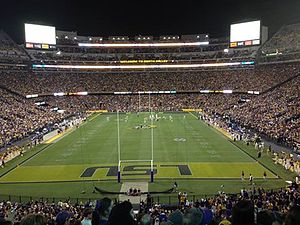Tiger Stadium (LSU)
| Tiger Stadium | |
|---|---|
| Death Valley "Where Opponent's Dreams Come to Die" |
|

|
|
| View of the completed end zone in the south (2014) | |
| Data | |
| place | West Stadium Road Baton Rouge , Louisiana 70893
|
| Coordinates | 30 ° 24 '43 " N , 91 ° 11' 8" W |
| owner | Louisiana State University |
| operator | LSU Athletics Department |
| start of building | 1924 |
| opening | November 25, 1924 |
| First game | November 25, 1924 Louisiana State University - Tulane University 0:13 |
| Renovations | 1994, 2006, 2011, 2014 |
| Extensions | 1931, 1936, 1953, 1978, 1988, 2000, 2014 |
| surface | Natural grass |
| costs | 1.8 million US dollars (1924) |
| capacity | 102,321 places (since 2014) 92,542 places (2011–2013) 92,400 places (2006–2010) 92,300 places (2005) 91,600 places (2000–2004) 79,940 places (1994–1999) 80,150 places (1993) 80,140 places (1988–1992 ) 78,882 places (1987) 77,542 places (1986) 76,869 places (1984–1985) 76,092 places (1978–1983) 67,744 places (1977) 67,720 places (1974–1976) 67,510 places (1966–1973) 67,508 places (1962–1965 ) 67,720 places (1953–1961) 46,000 places (1937–1952) 30,000 places (1936) 22,000 places (1931–1935) 12,000 places (1924–1930) |
| Societies) | |
|
|
The Tiger Stadium is a college football - stadium on the campus of Louisiana State University (LSU) in the US Baton Rouge , the capital of the state of Louisiana . The university's college football team, the LSU Tigers , plays its home games here. With 102,321 seats, it is the sixth largest stadium on a university campus in the United States and the eighth largest in the world .
history
The stadium was built in 1924 with 12,000 seats and was inaugurated on November 25th of that year. In 1931 it grew to 22,000 seats, and in 1936 24,000 new seats were added. In fact, the Louisiana Parliament had only earmarked money for new student dormitory spaces; however, Governor Huey P. Long interpreted the budget item in such a way that he had new dormitories built directly into the stadium and over them the 24,000 seats. By 1953 the stadium had 67,720 seats, with the expansion of the south stand it was transformed from a horseshoe shape into a completely enclosed stadium. After the expansion stage in the summer of 2006, the stadium had 92,400 seats by building box seats. In 2014, with the expansion of the south stand, the capacity was increased to 102,321 spectators.
The venue is one of, if not the, loudest stadiums in college football, and therefore one of the ones that gives the home team the greatest advantage. Several polls named Tiger Stadium the toughest in college football for an away team, including College Football Association 1987, The Sporting News 1989, Gannett News Service 1995, and Sport Magazine 1998. ESPN called the stadium the "scariest venue" by noting that it is by far the loudest stadium in the USA. ESPN measured 119 decibels in the stadium against Auburn in 2003 , and CBS measured 115 decibels in 2007 against Florida State University . The stadium's nickname is "Death Valley", which has evolved from the original "Deaf Valley" over the past few decades.
Tiger Stadium is one of three stadiums in college football in which the goal rests on two pillars instead of the usual one that forks. The more traditional construction that is found in Louisiana is often only used by other universities for major derbies, as they fear that their fans could otherwise seriously damage the gate and result in injuries.
In the NFL 2005 season playing New Orleans Saints four games at the stadium, as the Louisiana Superdome by Hurricane Katrina had been badly damaged.
In addition to football games, there are occasional concerts , mostly country music .
gallery
See also
Web links
- lsusports.net: The Tiger Stadium on the LSU website (English)
- lsusports.net: The Tiger Stadium in the LSU Media Guide 2014 - pages 34 and 35 ( PDF , English)
- preservedeathvalley.com: Tiger Stadium History (English)



